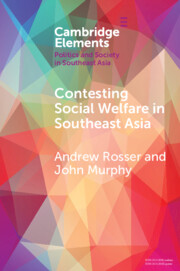277 results
Workflow and Outcome of Thrombectomy in Late Time Window: A Pooled Multicenter Analysis
-
- Journal:
- Canadian Journal of Neurological Sciences , First View
- Published online by Cambridge University Press:
- 19 April 2024, pp. 1-7
-
- Article
-
- You have access
- Open access
- HTML
- Export citation
The impact of badmouthing of medical specialties to medical students
-
- Journal:
- Irish Journal of Psychological Medicine , First View
- Published online by Cambridge University Press:
- 14 February 2024, pp. 1-8
-
- Article
-
- You have access
- Open access
- HTML
- Export citation
43 Transcutaneous Vagus Nerve Stimulation Effects on Functional Connectivity of the Hippocampus in Mild Cognitive Impairment
-
- Journal:
- Journal of the International Neuropsychological Society / Volume 29 / Issue s1 / November 2023
- Published online by Cambridge University Press:
- 21 December 2023, p. 454
-
- Article
-
- You have access
- Export citation

Contesting Social Welfare in Southeast Asia
-
- Published online:
- 10 June 2023
- Print publication:
- 06 July 2023
-
- Element
- Export citation
Design and implementation of a digital site-less clinical study of serial rapid antigen testing to identify asymptomatic SARS-CoV-2 infection
-
- Journal:
- Journal of Clinical and Translational Science / Volume 7 / Issue 1 / 2023
- Published online by Cambridge University Press:
- 10 May 2023, e120
-
- Article
-
- You have access
- Open access
- HTML
- Export citation
Economic Torts and Economic Wrongs. Edited by John Eldridge, Michael Douglas and Claudia Carr. [Oxford: Hart Publishing, 2021. xiv + 344 pp. Hardback £85.00. ISBN 978-1-50993-475-1.]
-
- Journal:
- The Cambridge Law Journal / Volume 82 / Issue 1 / March 2023
- Published online by Cambridge University Press:
- 26 April 2023, pp. 174-177
- Print publication:
- March 2023
-
- Article
- Export citation
The Effect of Sustained Poor Air Quality on EMS Call Volume and Characteristics: A Time-Stratified Case-Crossover Study
-
- Journal:
- Prehospital and Disaster Medicine / Volume 38 / Issue 1 / February 2023
- Published online by Cambridge University Press:
- 12 December 2022, pp. 17-22
- Print publication:
- February 2023
-
- Article
-
- You have access
- Open access
- HTML
- Export citation
27 - The Role of the Contract Research Organization in Alzheimer’s Disease: The Vital Link in the Clinical Drug-Development Program
- from Section 3 - Alzheimer’s Disease Clinical Trials
-
-
- Book:
- Alzheimer's Disease Drug Development
- Published online:
- 03 March 2022
- Print publication:
- 31 March 2022, pp 309-318
-
- Chapter
- Export citation
TORT'S HIERARCHY OF PROTECTED INTERESTS
-
- Journal:
- The Cambridge Law Journal / Volume 81 / Issue 2 / July 2022
- Published online by Cambridge University Press:
- 03 March 2022, pp. 356-383
- Print publication:
- July 2022
-
- Article
- Export citation
Management of lithium intoxication
-
- Journal:
- BJPsych Advances / Volume 29 / Issue 2 / March 2023
- Published online by Cambridge University Press:
- 28 February 2022, pp. 82-91
- Print publication:
- March 2023
-
- Article
-
- You have access
- HTML
- Export citation
Respiratory virus coinfections with severe acute respiratory coronavirus virus 2 (SARS-CoV-2) continue to be rare one year into the coronavirus disease 2019 (COVID-19) pandemic in Alberta, Canada (June 2020–May 2021)
- Part of
-
- Journal:
- Infection Control & Hospital Epidemiology / Volume 44 / Issue 5 / May 2023
- Published online by Cambridge University Press:
- 06 December 2021, pp. 805-808
- Print publication:
- May 2023
-
- Article
-
- You have access
- Open access
- HTML
- Export citation
Compounding and complementary carnivores: Australian bird species eaten by the introduced European red fox Vulpes vulpes and domestic cat Felis catus
-
- Journal:
- Bird Conservation International / Volume 32 / Issue 3 / September 2022
- Published online by Cambridge University Press:
- 02 December 2021, pp. 506-522
-
- Article
- Export citation
FLOODGATES FEARS AND THE UNLAWFUL MEANS TORT
-
- Journal:
- The Cambridge Law Journal / Volume 80 / Issue 3 / November 2021
- Published online by Cambridge University Press:
- 12 January 2022, pp. 436-439
- Print publication:
- November 2021
-
- Article
- Export citation
Three Essays on Torts. By Jane Stapleton. [Oxford University Press, 2021. xx + 101 pp. Hardback £60.00. ISBN 978-0-192-89373-4.]
-
- Journal:
- The Cambridge Law Journal / Volume 80 / Issue 3 / November 2021
- Published online by Cambridge University Press:
- 12 January 2022, pp. 616-621
- Print publication:
- November 2021
-
- Article
- Export citation
Neurocognitive Outcome Following Recovery from Severe Acute Respiratory Syndrome – Coronavirus-1 (SARS-CoV-1)
-
- Journal:
- Journal of the International Neuropsychological Society / Volume 28 / Issue 9 / October 2022
- Published online by Cambridge University Press:
- 07 September 2021, pp. 891-901
-
- Article
- Export citation
Frontmatter
-
- Book:
- Policy Analysis in Ireland
- Published by:
- Bristol University Press
- Published online:
- 18 December 2021
- Print publication:
- 05 March 2021, pp i-iv
-
- Chapter
- Export citation

